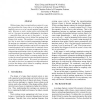Free Online Productivity Tools
i2Speak
i2Symbol
i2OCR
iTex2Img
iWeb2Print
iWeb2Shot
i2Type
iPdf2Split
iPdf2Merge
i2Bopomofo
i2Arabic
i2Style
i2Image
i2PDF
iLatex2Rtf
Sci2ools
ICSM
2009
IEEE
2009
IEEE
Understanding source package organization using the hybrid model
Within a large, object-oriented software system it is common to partition the classes into a set of packages, which implicitly serve as a set of coarsely-grained logical design units. However, as such a system evolves and design drift sets in, it becomes increasingly challenging for developers — especially those who are new to the project — to comprehend the underlying criteria behind the package-level design of the system. This problem is exacerbated by the fact that in most object-oriented programming languages the package (or namespace) construct has little semantics beyond that of a simple container, and so fails to capture the essential properties of the objects that its contained classes represent. In this paper, we propose an approach to uncovering package partitioning criteria by analyzing the collaboration patterns between packages. Our analysis approach is based on the Hybrid Model, a program model that describes the coarsely-grained structure and global behaviour of an ...
Coarsely-grained Logical Design | Design Drift Sets | ICSM 2009 | Object-oriented | Software Engineering |
Related Content
| Added | 23 May 2010 |
| Updated | 23 May 2010 |
| Type | Conference |
| Year | 2009 |
| Where | ICSM |
| Authors | Xinyi Dong, Michael W. Godfrey |
Comments (0)

